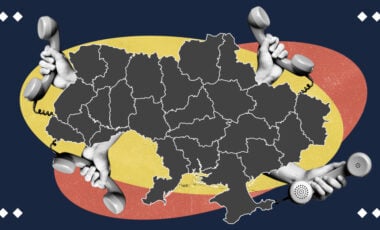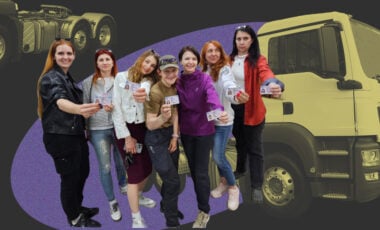Eco-solutions: Kyiv beautifies tram tracks with green lawns instead of concrete slabs

Plants between tram tracks can be sown or laid out in ready-made rolls. This is a screenshot from the video of the Department of Environmental Protection and Adaptation to Climate Change
In the city center, the tram tracks were beautified with a lawn instead of being paved with concrete slabs. Rubryka interviewed urban planner Mariia Holiuk to discuss the reasoning behind this decision.
What is the problem?
Dirty air, noise, and sweltering heat in the summer – a scene all too familiar to those living in big cities. The insufficient presence of green spaces only exacerbates the issue, as the abundance of concrete and asphalt can make it feel like an "urban jungle" where breathing, moving, and relaxing prove difficult. This all adds to the existing stress and exhaustion experienced by Ukrainians.
What is the solution?
Today, incorporating green elements into urban spaces is not just a passing trend but rather an essential measure for building comfortable, thriving, and sustainable cities. The environment and the community's well-being improve when green spaces are cultivated and preserved. The greater the amount of greenery in a city, the more content and healthy its inhabitants tend to be.
This year, the Department of Environmental Protection and Adaptation to Climate Change of Kyiv City State Administration initiated several experiments to enhance the city's environmental state. These included introducing meadow grasses, vertical greening, and constructing rain gardens. Additionally, working together with the Department of Transport, the city has introduced parklets, street furniture adorned with greenery, and even green tram tracks.
Yes, one of the city's parks now has green tram tracks. In the Kyiv Darnytskyi Wagon Repair Plant Village district, the concrete slabs between the tram tracks have been replaced with grass. Oleksandr Vozny, director of the Department of Environmental Protection and Adaptation to Climate Change, announced this.
Thanks to the assistance from the "Kusum" group of companies and the efforts of the Communal enterprise for Maintaining Green Spaces in the Dnipro district, a new tram stop has been installed in the square. Additionally, new pathways, benches, and trash bins have been placed, and an automatic watering system is now operational.
"And, of course, the enchanting "green" tram tracks add a unique touch to the atmosphere. But this is just the tip of the iceberg. Shortly, there will be charming hornbeam tunnels, stunning arrays of ornamental grasses and hydrangeas, and lush green walls of wild grapes. That's why we cordially invite all Kyiv residents to visit this place and experience its exceptional beauty for themselves!" Oleksandr Vozny said, presenting a new modern zone for recreation and rehabilitation in front of building 60 on Almaty Street.
How does it work?
What are green tracks, and what is their purpose?

Plants between tram tracks can be sown or laid out in ready-made rolls. This is a screenshot from the video of the Department of Environmental Protection and Adaptation to Climate Change
According to Mariia Holiuk, the chief landscape architect at MASSHTAB bureau, green tracks offer a nature-friendly approach for cities, as they involve planting grass along tram routes. This solution has undeniable positive effects on urban spaces and should not be overlooked.
- The first item is a waterproof covering made of turf. This means that it absorbs a significant amount of water on rainy days, helping to alleviate pressure on the sewage system and mitigate the risk of flooding, a crucial aspect amidst the effects of climate change.
- Secondly, the grass covering helps cool the air, positively impacting cities by reducing summer temperatures. A lawn can lower the ground temperature by up to 20 °C and the air temperature by 10 °C. When comparing the temperatures of asphalt and grass surfaces in the summer, it is clear that the soil will have a lower temperature.
- Thirdly, the tram is quite a noisy form of transportation. However, the grass cover significantly reduces the noise and vibrations by up to 4-8 decibels.
- Furthermore, this approach allows cities to expand their green spaces, enhance local biodiversity, enhance the aesthetic appeal of the urban environment, and promote the use of public transportation.
"I saw such solutions in Berlin. It is both expedient and effective from the point of view of the economy. Green tracks improve the landscape environment, increase comfort (less noise, lower surface temperature), and adapt cities to climate changes," Mariia Holiuk.
Will it work for sure?
According to the landscape architect, there is no need to be concerned about the grass-covered tram tracks deteriorating faster, as some residents of Kyiv expressed on social media.
"I don't notice a distinction in its maintenance and rusting. In other words, if there is simply rain and some puddles on the cobblestones or asphalt, the track won't rust. And if a layer of grass on the green track has good drainage, there shouldn't be any issues. Plus, tram tracks are made of a specific type of metal that can withstand the harsh conditions of a busy street and normally tolerates everything expected: rust, flexibility, etc.," Mariia Holiuk comments.
Of course, not without peculiarities regarding the operation and the grass cover itself. Vegetation can somewhat complicate access to maintenance of railroad ties and require more intensive maintenance.
"Obviously, mowing during traffic is dangerous, but you can organize a schedule. And if you choose the right plants, there will often be no need to mow. In addition, it may not be a lawn but a city meadow that does not require much maintenance, watering, etc. A mixture of seeds which meadow can be different, it is not necessarily high, it is similar to a blade of grass, so it will not hinder the movement of trams," the expert says.
Even more helpful solutions!

Green tram tracks in Warsaw. Photo: Facebook
Today, many European cities with tram connections are implementing this solution. The most prominent examples include Barcelona, Strasbourg, Berlin, Paris, and Warsaw. It is also possible for Ukrainian cities to have more green lanes. However, according to Mariia Holiuk, this requires local authorities' desire, practicality, and action.
"City residents can also act as initiators of such changes, but the expert opinion of everyone involved in the design and maintenance of streets in the city cannot be dispensed with. You can submit a proposal to local self-government bodies for review and initiate an idea, but everything will depend on the scale of the changes in the reconstruction project, the opinions of experts and the council, and, of course, the existing budget," Mariia Holiuk stresses.
Naturally, changing and reconstructing a street involves numerous bureaucratic procedures, making it more challenging than starting a landscaping project for a yard or playground. Nonetheless, the landscape architect believes suggesting and discussing such expertise is imperative.
"But everything still has to have its place. It's not worth proposing such solutions everywhere. I can't imagine it, for example, on the historic streets of Lviv," the expert adds.
For reference:
In 2024, the capital of Ukraine, Kyiv, will continue experimenting with decorative meadows and refusing to cut grass.
In addition, a "green wall" was created in Lviv in Bernardynsky Dvoryk, near the Church of St. Andrew, as part of the urban festival of the City Workshop 2024.




















































